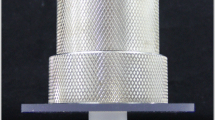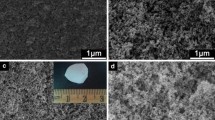Abstract
We reported the preparation of a series of ZrO2-SiO2 composite aerogels via the sol-gel reaction between the zirconium source (ZrOCl2·8H2O) and the gel initiator (mercaptosuccinic acid-triethoxyvinylsilane). Such novel gel gelator was prepared by the thiol-ene click reaction using triethoxyvinylsilane (VTES) and mercaptosuccinic acid (MSA). The unique molecule structure of the gel initiator allows the in-situ modification of ZrO2 with SiO2 in the sol-gel reaction, which was achieved by the hydrolysis and polycondensation of siloxane with the change of the pH spontaneously. SiO2 with the controllable content can be in-situ introduced into ZrO2 backbone. As a result, the composite aerogel showed better thermal stability compared with pristine ZrO2 aerogel, proved by the following facts: (i) the aerogels remained amorphous after calcination in air at 600 °C; (ii) the specific surface area maintained at 53.4 m2/g when the temperature rising to 1000 °C.

ZrO2-SiO2 composite aerogels with improved thermal stability have been prepared via the “thiol-ene” click section
Highlights
-
ZrO2-SiO2 composite aerogels have been prepared via the “thiol-ene” click reaction from the zirconium source (ZrOCl2·8H2O) and the gel initiator (mercaptosuccinic acid-triethoxyvinylsilane).
-
The introduction of SiO2 into ZrO2 aerogel with the controllable content can be achieved by the in-situ hydrolysis of the gel initiator.
-
The ZrO2-SiO2 composite aerogel showed better thermal stability compared with pristine ZrO2 aerogel.







Similar content being viewed by others
References
Stöcker C, Schneider M, Baiker A (1995) Zirconia aerogels and xerogels: influence of solvent and acid on structural properties. J Porous Mater 2(2):171–183
Wang ML, Liu BL, Ren CC, Shih ZW (1997) Preparation of the precursor of the zirconium oxide in EDTA-ammonia solution by the sol-gel method. Ind Eng Chem Res 36(6):2149–2155
Bangi UKH, Jung HNR, Park CS, Mahadik DB, Park HH (2016) Effect of thermal treatment on the textural properties and thermal stability of surface modified zirconia aerogel powders. Int J Nanotechnol 13:452–462
Shi Z, Gao H, Wang X, Li C, Wang W, Hong Z, Zhi M (2018) One-step synthesis of monolithic micro-nano yttria stabilized ZrO2-Al2O3 composite aerogel. Micro Meso Mater 259:26–32
Wu ZG, Zhao YX, Liu DS (2004) The synthesis and characterization of mesoporous silica-zirconia aerogels. Micro Meso Mater 68(1):127–132
Wang Q, Li X, Fen W, Ji H, Sun X, Xiong R (2014) Synthesis of crack-free monolithic ZrO2 aerogel modified by SiO2. J Porous Mater 21(2):127–130
Ren J, Cai X, Yang H, Guo X (2015) Preparation and characterization of high surface area ZrO2 aerogel modified by SiO2. J Porous Mater 22(4):973–978
Zu G, Shen J, Zou L, Wang W, Lian Y, Zhang Z, Du A (2013) Nanoengineering super heat-resistant, strong alumina aerogels. Chem Mater 25(23):4757–4764
Zu G, Shen J, Zou L, Zou W, Guan D, Wu Y, Zhang Y (2017) Highly thermally stable zirconia/silica composite aerogels prepared by supercritical deposition. Micro Meso Mater 238:90–96
Gao H, Zhang Z, Shi Z, Zhang J, Zhi M, Hong Z (2018) Synthesis of high-temperature resistant monolithic zirconia-based aerogel via facile water glass assisted sol-gel method. J Sol-Gel Sci Techn 85(3):567–573
Zhang Z, Gao Q, Liu Y, Zhou C, Zhi M, Hong Z, Zhang F, Liu B (2015) A facile citric acid assisted sol-gel method for preparing monolithic yttria-stabilized zirconia aerogel. RSC Adv 5(102):84280–84283
Wang X, Li C, Shi Z, Zhi M, Hong Z (2018) The investigation of an organic acid assisted sol-gel method for preparing monolithic zirconia aerogels. RSC Adv 8(15):8011–8020
Zhang Z, Gao Q, Gao H, Shi Z, Wu J, Zhi M, Hong Z (2016) Nickel oxide aerogel for high performance supercapacitor electrodes. RSC Adv 6(113):112620–112624
Gao Q, Wang X, Shi Z, Ye Z, Wang W, Zhang N, Hong Z, Zhi M (2018) Synthesis of porous NiCo2S4 aerogel for supercapacitor electrode and oxygen evolution reaction electrocatalyst. Chem Eng J 331:185–193
Hoyle CE, Bowman CN (2010) Thiol-ene click chemistry. Angew Chem Int Ed 49(9):1540–1573
Hoyle CE, Lee TY, Roper T (2004) Thiol-enes: chemistry of the past with promise for the future. J Polym Sci Part A: Polym Chem 42(21):5301–5338
Yun S, Luo HJ, Gao YF (2015) Low-density, hydrophobic, highly flexible ambient-pressure-dried monolithic bridged silsesquioxane aerogels. J Mater Chem A 3(7):3390–3398
Xue L, Wang D, Yang Z, Liang Y, Zhang J, Feng S (2013) Facile, versatile and efficient synthesis of functional polysiloxanes via thiol-ene chemistry. Eur Polym J 49(5):1050–1056
Guo X, Song J, Ren J, Yang F, Kanamori K, Nakanishi K (2016) Facile preparation of well-defined macroporous yttria-stabilized zirconia monoliths via sol-gel process accompanied by phase separation. J Porous Mater 23(4):867–875
Akhtar MN, Chen YC, AlDamen MA, Tong ML (2017) 3D oxalato-bridged lanthanide (III) MOFs with magnetocaloric, magnetic and photoluminescence properties. Dalton Trans 46(1):116–124
Shi RH, Zhang ZR, Fan HL, Zhen T, Ju S, Mi J (2017) Cu-based metal-organic framework/activated carbon composites for sulfur compounds removal. Appl Surf Sci 394:394–402
Sahiner N, Demirci S, Yildiz M (2017) Preparation and characterization of bi-etallic and tri-metallic metal organic frameworks based on trimesic acid and Co (II), Ni (II), and Cu (II) ions. J Electron Mater 46(2):790–801
Lavoine N, Bras J, Saito T, Isogai A (2017) Optimization of preparation of thermally stable cellulose nanofibrils via heat-induced conversion of ionic bonds to amide bonds. J Polym Sci Part A: Polym Chem 55(10):1750–1756
Xiong R, Li X, Ji H, Sun X, He J (2014) Thermal stability of ZrO2-SiO2 aerogel modified by Fe (III) ion. J Sol-Gel Sci Technol 72(3):496–501
Chakhari S, Younes MK, Rives A, Ghorbel A (2015) Effect of the doping agent nature on the characteristic and catalytic properties of aerogel zirconia catalysts doped with sulfate groups or heteropolytungstic acid. Mater Res Bull 72:35–42
Li X, Jiao Y, Ji H, Sun X (2013) The effect of propylene oxide on microstructure of zirconia monolithic aerogel. Integr Ferroelectr 146(1):122–126
He J, Li X, Su D, Ji H, Zhang X, Zhang W (2016) Super-hydrophobic hexamethyl-disilazane modified ZrO2-SiO2 aerogels with excellent thermal stability. J Mater Chem A 4(15):5632–5638
Pyen S, Hong E, Shin M, Suh YW, Shin CH (2018) Acidity of co-precipitated SiO2-ZrO2 mixed oxides in the acid-catalyzed dehydrations of iso-propanol and formic acid. Mol Catalysis 448:71–77
Chao X, Yuan W, Shi Q, Zhu Z (2016) Improvement of thermal stability of zirconia aerogel by addition of yttrium. J Sol-Gel Sci Technol 80(3):667–674
Zhong L, Chen X, Song H, Guo K, Hu Z (2014) Synthesis of monolithic zirconia aerogel via a nitric acid assisted epoxide addition method. RSC Adv 4(60):31666–31671
Zhao Z, Chen D, Jiao X (2007) Zirconia aerogels with high surface area derived from sols prepared by electrolyzing zirconium oxychloride solution: comparison of aerogels prepared by freeze-drying and supercritical CO2 (l) extraction. J Phys Chem C 111(50):18738–18743
Mejri I, Younes MK, Ghorbel A (2006) Comparative study of the textural and structural properties of the aerogel and xerogel sulphated zirconia. J Sol-Gel Sci Technol 40(1):3–8
Fenech J, Viazzi C, Bonino JP, Ansart F, Barnabé A (2009) Morphology and structure of YSZ powders: comparison between xerogel and aerogel. Ceram Int 35(8):3427–3433
Acknowledgements
This work is supported by National key research and development program (grant no. 2016YFB0901600) and NSCF (grant no. 21303162 and grant no. 11604295).
Author information
Authors and Affiliations
Corresponding authors
Ethics declarations
Conflict of interest
The authors declare that they have no conflict of interest.
Electronic supplementary material
Rights and permissions
About this article
Cite this article
Wang, X., Wu, Z., Zhi, M. et al. Synthesis of high temperature resistant ZrO2-SiO2 composite aerogels via “thiol-ene” click reaction. J Sol-Gel Sci Technol 87, 734–742 (2018). https://doi.org/10.1007/s10971-018-4766-z
Received:
Accepted:
Published:
Issue Date:
DOI: https://doi.org/10.1007/s10971-018-4766-z




